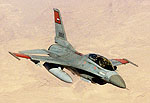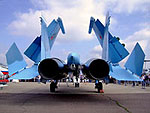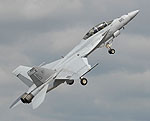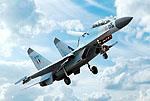A force to be reckoned with
Initially it had close links with the British Royal Air Force and was primarily equipped with British-supplied aircraft. Spitfires gave way to Meteors and Vampires before the 1952 revolution, after which the new president, General Gamal Abdel Nasser, turned to the Soviet Union .
The Egyptian air force was forged in a succession of hard-fought wars; against Israel in 1948, 1956, 1967 and 1973, against Libya in 1977, and supporting Republican Yemeni forces against Saudi-backed Royalist forces (1962-70). This gave it considerable combat experience, though most veterans have now retired.
Egypt ’s close relationship with the USSR was brought to an end by president Anwar El Sadat in 1972. National identity was reinforced and the EAF founded a formation display team – the ‘Silver Stars’ – equipped with four L-29 jet trainers.
The air force also began to reduce its reliance on Soviet equipment and introduced Mirage fighters into the inventory, initially via a loan arrangement with Libya and subsequently through the purchase of some 54 Mirage 5s with Saudi Arabian funding.
Following the signature of the Camp David Accords by president Sadat and Israeli Prime Minister Menachem Begin on September 17, 1978, and the subsequent 1979 Israel-Egypt Peace Treaty, Egypt lost the support of many of its Arab neighbours. Saudi Arabian plans to send 50 F-5s to Egypt were cancelled. Instead, a new relationship was forged with the USA . Thereafter, Egypt would turn to the USA , France , and later China , for its new aircraft and weapons and the air force increasingly began to train with the USAF and its allies.
One of the first fruits of the new relationship came in September 1977, when 35 ex-USAF F-4Es (armed with Sparrow, Sidewinder and Maverick missiles) were supplied to the EAF at a cost of US$594 million under the Peace Pharaoh programme. Ten further aircraft were supplied subsequently and the survivors still serve with 76 and 78 Squadrons of the 222 Fighter Regiment.
Behind the scenes, Egyptian cash was augmented by a more secretive arrangement under which large numbers of its Soviet-built fighters (including MiG-17s, MiG-21s, MiG-23s and Su-20s) were sent to the USA for analysis and for use in a secretive adversary training programme. Other Soviet-built fighters were supplied to other US allies for evaluation, and a few to China .
From 1980, US and Egyptian ground forces began training together in the Operation Bright Star series of exercises. These were progressively expanded in scope, adding air force participation from 1985. Today Bright Star is held every two years and involves tactical air, ground, naval and special operations forces from a number of nations including France , Germany , Greece , Italy , Jordan , Kuwait , the Netherlands , the United Arab Emirates and the United Kingdom , as well as the USA and Egypt .
From 1982, Egypt began receiving the first of 240 F-16 fighters under the initial phase of the seven-stage Peace Vector Programme. The F-16 today forms the backbone of the EAF. With some 200 in service, it is the world’s fourth largest F-16 operator.
The EAF’s F-16s still serve in the air defence and tactical fighter roles, and have been upgraded to enable them to fire the AGM-84 Harpoon anti-ship missile. The 40 Block 32 F-16C/Ds (34 Cs and six Ds) delivered under Peace Vector II were compatible with the AIM-7 Sparrow, giving them a robust air combat capability.
Other deliveries from the USA included five E-2C Hawkeye Airborne Early Warning aircraft, which entered service in 1987 (these were later upgraded with advanced AN/APS-145 radars and augmented by a sixth example). In 1995 the EAF received ten SH-2G Seasprite helicopters for use aboard the Egyptian Navy’s two ex-USN Knox-class and four ex-USN Oliver Hazard Perry class frigates.
Egypt also received 36 AH-64A Apaches (35 survivors were upgraded to AH-64D standards in 2001).
The country ordered 15 Elicopteri Meridionali-built CH-47C Chinooks in 1980 and Boeing began upgrading 12 of these to CH-47D standards from 2002; these subsequently joining four new-build D-models in 1998.
But Egypt was not content to rely solely on the USA for the supply of weapons, and placed significant orders for French equipment, following the success of the Mirage 5.
Egypt ordered 30 Alpha Jet MS1 trainers, with Dassault delivering the first four complete aircraft from June 1983. The remaining 26 were supplied in kit form for assembly in Egypt .
Egypt also received 15 examples of a close support version of the Alpha Jet, designated MS2. These incorporated a TMV630 laser rangefinder in a modified nose, together with a digital avionics suite, including a SAGEM ULISS 81 INS, and a Thomson-CSF VE-110 HUD. Dassault delivered the first four complete and the remainder were assembled locally.
The Silver Stars converted to the new Alpha Jet in 1984 and increased from six to nine Alpha Jets in 1985.
The EAF was the first export customer for the Mirage 2000, ordering 20 aircraft in late 1981. Deliveries began in 1986 and the EAF formed a single squadron with 16 single-seat Mirage 2000EMs and four two-seat Mirage 2000BMs, which became operational in 1987. Financial problems put paid to plans for a second squadron, but the survivors continue to serve as multi-role fighters, armed with Matra Super 530D medium range semi-active radar guided air-air missiles and AS30L laser guided air-to-ground missiles.
Egypt also license-built armed and unarmed variants of the French Gazelle helicopter for its armed forces and significant numbers remain in use.
The country turned to Brazil to address its need for a new basic trainer, becoming the first export customer for the Embraer EMB 312 Tucano. It placed an initial order for 40, ten delivered direct from Embraer from 1984, and 30 assembled locally between 1985 and 1988. The Egyptians ordered 14 more in 1989. The Helwan factory also assembled 80 aircraft for Iraq .
Egypt also forged a relationship with China , ordering 150 Chengdu F-7s (the unlicensed Chinese copy of the MiG-21) to beef up its fighter force. The Egyptians received a mix of F-7Bs and much improved F-7M Airguard fighters, the latter featuring western avionics, including a GEC Type 226 Skyranger radar and a Type 956 HUDAWAC.
In 1999, Egypt agreed to buy 80 K-8E (JL-8) Karakorum advanced trainers to be built in country from Chinese-supplied kits. Compared to the basic K-8, the K-8E for Egypt incorporated 33 modifications to the airframe and avionics. The K-8E prototype made its first flight on June 5 2000 and deliveries were completed in 2005. License production of an additional batch of 40 K-8Es began immediately. The K-8E re-equipped the Silver Stars team in 2004, and the type augments the Alpha Jet in the training role.
In terms of aircraft numbers, the largest recent EAF order was for 68 Grob G-115 primary trainers. Other orders have been for small numbers of aircraft, often to top up in-service aircraft fleets. Three ex Danish C-130H Hercules were acquired in 2004, for example, and in May 2009, Egypt made an official request to buy ten AH-64D Apache Block II attack helicopters, though these still lack Longbow targeting radar.
Upgrades have been undertaken on surviving MiG-21s, which have gained glass cockpits, helmet-mounted sights, and R-73 missiles, and to the air force’s six E-2C Hawkeyes, which are being upgraded to Hawkeye 2000 standards.
Perhaps the most important upgrade programme has seen the air force’s older Block 15 and 32 F-16s outfitted with most of the features of the Block 40/42 features, fitted with holographic HUDs and able to carry LANTIRN pods and AGM-88 HARM missiles.
For some years, the Egyptian air force has had a requirement for a more capable strike fighter than the F-16. Egypt requested 12 F-15E Strike Eagles in 2002, but this request was turned down, as was a 2005 request for the supply of 60-100 F-16C/D Block 60/62s.
After this rebuff, in November 2006, Egypt began talks with Mikoyan hoping to buy 40 MiG-29SMT fighters. By 2007, it was negotiating for a larger batch of 60-80 MiG-29SMTs, 20-25 Sukhoi Su-35s and 24-40 Yak-130 advanced trainer/light support aircraft. Subsequently, there were reports of Egyptian negotiations to join the Sino-Pakistani JF-17 programme, with a reported interest in taking 48 of these advanced fighters.
The chance that Egypt might buy Russian or Chinese fighters encouraged the USA to view the country’s request for advanced F-16s more sympathetically and, as a result, the EAF will now receive a batch of 16 F-16C Block 52+ and four F-16D Block 52s, together with JDAM kits for the EAF’s stock of Mk84 bombs. The supply of AIM-120 AMRAAM beyond visual range missiles remains problematic, however.
The EAF today is the primary aviation branch of the Egyptian Armed Forces. The air force has an inventory of 806 aircraft, including 586 combat aircraft and 149 armed helicopters. The force has 20,000 personnel, based at 20 main bases, and includes 22 frontline fast jet fighter squadrons. The air force operates 48 R4E-50 Skyeye UAVs, two Camcopter UAVs and 50 324 Scarab unmanned vehicles.
The EAF is backed by a dedicated Air Defence Command with US AN/TPS-93 and AN/TPS-63 radar systems augmenting a dwindling number of Soviet-produced radar systems. Air Defence Command’s five territorial divisions incorporate 60 Surface to Air Missile units with the S-125 Kub (SA-3 ‘Goa ’) system and an approximately equal number of S-75 Dvina systems. Egypt also uses US I-HAWK and Raytheon Patriot SAMs, some 26 self-propelled Chaparral launcher systems, Crotale SAMs and a range of anti-aircraft artillery gun systems.
traducción:
Una fuerza que se contará con
Inicialmente se tenía estrechos vínculos con la Real Fuerza Aérea británica y estaba equipado principalmente con aviones británicos-se suministra. Spitfires dieron paso a Meteoros y vampiros antes de la revolución de 1952, tras lo cual el nuevo presidente, el general Gamal Abdel Nasser, se volvió hacia la Unión Soviética.
La fuerza aérea egipcia se forjó en una sucesión de guerras reñida; contra Israel en 1948, 1956, 1967 y 1973, contra Libia en 1977, y el apoyo a las fuerzas republicanas de Yemen contra las fuerzas realistas con respaldo saudí (1962-1970). Esto le dio una considerable experiencia en combate, aunque la mayoría de los veteranos se han retirado.
Egipto 's estrecha relación con la Unión Soviética llegó a su fin por el presidente Anwar El Sadat en 1972. La identidad nacional se reforzó y la EEP fundó un equipo de formación de pantalla - 'Silver Stars - equipado con cuatro L-29 reactores entrenadores.
La fuerza aérea también comenzó a reducir su dependencia del equipo soviético y presentó cazas Mirage en el inventario, inicialmente a través de un acuerdo de préstamo con Libia y, posteriormente, mediante la compra de unos 54 Mirage 5s con Arabia Saudita financiación.
Tras la firma de los Acuerdos de Camp David por el presidente Sadat y el primer ministro israelí Menachem Begin el 17 de septiembre de 1978, 1979 y la posterior de Israel-Egipto Tratado de Paz, Egipto perdió el apoyo de muchos de sus vecinos árabes. Arabia Saudita planea enviar 50 F-5 a Egipto fueron cancelados. En su lugar, una nueva relación se forjó con los EE.UU.. A partir de entonces, Egipto a su vez a los EE.UU., Francia, y más tarde China, por su nuevos aviones y armas y la fuerza aérea cada vez más comenzó a entrenar con la USAF y sus aliados.
Uno de los primeros frutos de la nueva relación fue en septiembre de 1977, cuando 35 ex-USAF F-4ES (armado con Sparrow, Sidewinder y misiles Maverick) se suministraron en el EEP a un costo de EE.UU. 594 millones dólares bajo el programa Peace Faraón. Diez aviones más han sido proporcionados posteriormente y los supervivientes siguen cumpliendo con 76 y 78 escuadrones de la 222 Regimiento de Caza.
Detrás de las cámaras, dinero en efectivo de Egipto se ha ampliado con un arreglo más secretas en las que un gran número de sus combatientes soviéticos de la región (incluidos los MiG-17, MiG-21, MiG-23 y Su-20) fueron enviados a los EE.UU. para su análisis y para utilizarlos en un programa de formación adversario secreto. Otros luchadores de fabricación soviética fueron suministrados a otros aliados de los EE.UU. para la evaluación, y unos pocos a China.
Desde 1980, las fuerzas de EE.UU. y Egipto suelo comenzó a entrenar juntos en la serie de la Operación Estrella Brillante de ejercicios. Éstas se ampliaron progresivamente en su alcance, la adición de la participación de la fuerza aérea de 1985. Hoy Bright Star se celebra cada dos años e implica aéreo táctico, terrestres, navales y las fuerzas especiales de operaciones de una serie de naciones como Francia, Alemania, Grecia, Italia, Jordania, Kuwait, Países Bajos, los Emiratos Árabes Unidos y el Reino Unido, así como los EE.UU. y Egipto.
Desde 1982, Egipto comenzó a recibir el primero de 240 cazas F-16 en la etapa inicial de las siete etapas del Programa Paz vectoriales. El F-16 hoy forma la columna vertebral de la EEP. Con unos 200 en servicio, es el mundo el cuarto mayor operador de aviones F-16.
El EEP los F-16 todavía sirven en la defensa aérea y tácticas de combate, y se han actualizado a fin de que puedan disparar el AGM-84 Harpoon misiles anti-buque. El 40 Bloque 32 F-16C/Ds (34 Cs y Ds seis) entregadas en virtud de la Paz vectores II eran compatibles con el AIM-7 Sparrow, dándoles una capacidad de combate aéreo robusto.
Otras entregas de los EE.UU. incluyó cinco E-2C Hawkeye Airborne avión de alerta temprana, que entró en servicio en 1987 (estos fueron luego mejorados con radares avanzados AN/APS-145 y aumentada por un sexto ejemplo). En 1995, la EEP recibió diez helicópteros SH-2G Seasprite para uso a bordo de dos egipcios de la Armada de la ex-USN Knox-clase y cuatro franco USN Oliver Hazard Perry fragatas de la clase.
Egipto también recibió 36 Apaches AH-64A (35 sobrevivientes fueron actualizados a las normas AH-64D en 2001).
El país pidió 15 CH-47C Elicopteri Chinooks Meridionali-construido en 1980 y Boeing comenzó a mejorar a 12 de estas normas CH-47D de 2002, los cuales posteriormente unirse a cuatro nuevas unidades del D-modelos en 1998.
Sin embargo, Egipto no se contentó con confiar solamente en los EE.UU. para el suministro de armas, así como los pedidos importantes para el equipo francés, tras el éxito de los 5 Mirage.
Egipto pidió 30 Alpha Jet MS1 formadores, con Dassault la entrega de las primeras cuatro aeronaves completas a partir de junio de 1983. Los restantes 26 fueron suministradas en forma de kit para su montaje en Egipto.
Egipto también recibió 15 ejemplos de apoyo a una versión final del Alpha Jet, designado MS2. Estos incorporan un telémetro láser TMV630 en una nariz modificada, junto con un conjunto de aviónica digital, incluyendo un SAGEM Uliss 81 INS, y un HUD Thomson-CSF VE-110. Dassault entregó los cuatro primeros completa y el resto fueron ensamblados localmente.
Las Estrellas de Plata convierte a la nueva Alpha Jet en 1984 y un aumento de seis hasta nueve Alpha Jets en 1985.
La EEP fue el primer cliente de exportación para el ordenamiento Mirage 2000, 20 aviones a finales de 1981. Las entregas comenzaron en 1986 y EEP formaron un escuadrón con 16 monoplazas Mirage 2000EMs y cuatro biplaza Mirage 2000BMs, que entró en funcionamiento en 1987. Los problemas financieros dieron al traste con los planes para un segundo escuadrón, pero los sobrevivientes continúan sirviendo como combatientes multi-función, armados con misiles Matra Super 530D de medio alcance del radar semi-activo guiados aire-aire y misiles guiados por láser AS30L aire-tierra.
Egipto armados y desarmados variantes también construido bajo licencia de los franceses helicóptero Gazelle de sus fuerzas armadas y un número importante continuar en uso.
El país se volvió a Brasil para hacer frente a su necesidad de un entrenador de base nueva, convirtiéndose en el primer cliente de exportación para el EMB 312 Tucano de Embraer. Se hizo un pedido inicial de 40, diez de la entrega directa de Embraer a partir de 1984, y 30 ensamblados localmente entre 1985 y 1988. Los egipcios ordenó 14 más en 1989. La fábrica también Helwan montado 80 aviones para el Iraq.
Egipto también forjó una relación con China, ordenando 150 Chengdu F-7 (la copia no autorizada en chino del MiG-21) para reforzar su fuerza de combate. Los egipcios recibieron una combinación de F-7B y muy mejorado combatientes Airguard 7m F-, este último con aviónica occidental, incluyendo un GEC Tipo 226 y un radar Skyranger HUDAWAC Tipo 956.
En 1999, Egipto acordó la compra de 80 K-8E (JL-8) Karakorum avanzada formadores que se construirá en el país a partir de kits suministrados por China. En comparación con la base K-8, K-8E de Egipto incorporado 33 modificaciones en el fuselaje y de aviónica. El prototipo de K-8E hizo su primer vuelo el 5 de junio de 2000 y las entregas se completaron en 2005. licencia de producción de un lote adicional de 40 K-8ES comenzó de inmediato. El K-8E reequipado el equipo Estrellas de Plata en 2004, y el tipo aumenta el Alpha Jet en el papel de formación.
En cuanto al número de aviones, el mayor recientes para el EEP fue el 68 Grob G-115 formadores primarios. Otras órdenes han sido por un pequeño número de aviones, a menudo al principio en el servicio flotas de aviones. Tres ex danesa C-130H Hercules fueron adquiridos en 2004, por ejemplo, y en mayo de 2009, Egipto presentó una solicitud oficial para comprar diez 64D Apache AH-Bloque II helicópteros de ataque, aunque éstos aún carecen de la orientación de radar Longbow.
Las actualizaciones se han realizado en sobrevivir MiG-21, que han ganado cabinas de vidrio, casco montados en las vistas, y los misiles R-73, ya seis de la fuerza aérea E-2C Hawkeye, que se están modernizando para Hawkeye 2000 normas.
Tal vez el programa de actualización más importante ha sido testigo de la fuerza aérea es mayor del Bloque 15 y 32 F-16 equipado con la mayoría de las características del Bloque 40/42 características, equipado con HUD holográfico y capaz de llevar las vainas LANTIRN y misiles AGM-88 HARM.
Desde hace algunos años, la fuerza aérea egipcia ha tenido un requisito para un cazabombardero más capaz que el F-16. Egipto pidió 12 F-15E Strike Eagles en 2002, pero esta petición fue rechazada, al igual que una solicitud de 2005 para el suministro de 16 C 60-100 F-60/62s / D Block.
Después de este rechazo, en noviembre de 2006, Egipto inició conversaciones con Mikoyan con la esperanza de comprar 40 cazas MiG-29SMT. Para el año 2007, se estaba negociando un lote grande de 60-80 MiG-29SMTs, 20-25 Sujoi Su-35 y 24-40 Yak-130 entrenador avanzado / avión de apoyo ligero. Posteriormente, se informó de las negociaciones de Egipto para unirse a las relaciones sino-pakistaníes JF-17 programa, con un interés informó en la toma de 48 de estos cazas avanzados.
La posibilidad de que Egipto podría comprar aviones caza rusos o chinos alentó a los EE.UU. para ver la solicitud del país para avanzados F-16 con mayor simpatía y, como resultado, la EEP ahora recibirán un lote de 16 F-16C Bloque 52 + y cuatro F- 16D Bloque 52, junto con los kits JDAM de las acciones de la EEP de bombas Mk84. El suministro de AMRAAM AIM-120 más allá de los misiles de alcance visual sigue planteando problemas, no obstante.
El EEP hoy es la rama principal de la aviación egipcia Fuerzas Armadas. La fuerza aérea tiene un inventario de 806 aviones, incluyendo 586 aviones de combate y 149 helicópteros armados. La fuerza tiene 20.000 efectivos, con sede en 20 bases principales, que dispone de 22 escuadrones de primera línea rápida jet de combate. La Fuerza Aérea opera R4E 48-50 Skyeye vehículos aéreos no tripulados, vehículos aéreos no tripulados dos CAMCOPTER y 50 324 vehículos no tripulados Escarabajo.
La EAF está respaldado por una dedicada Comando de Defensa Aérea con sistemas de radar de EE.UU. y AN/TPS-93 AN/TPS-63 aumentar un número cada vez menor de los sistemas de radar de producción soviética. cinco divisiones territoriales Comando de Defensa Aérea de incorporar 60 unidades de tierra-aire de misiles con el S-125 de Goa Kub (SA-3 ') del sistema y un número aproximadamente igual de S-75 Dvina sistemas. Egipto también utiliza EE.UU. I-HAWK y Raytheon Patriot SAM, a unos 26 sistemas autopropulsados Chaparral lanzador, SAM Crotale y una gama de sistemas antiaéreos arma de artillería.
slds,
moises













